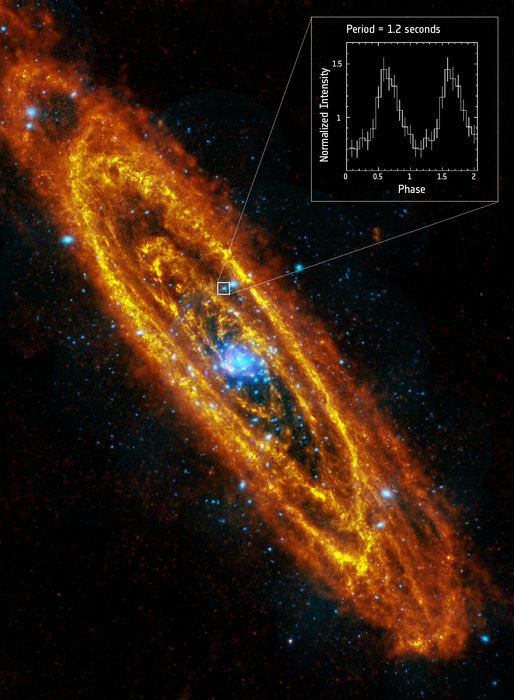
 Credit: Andromeda: ESA/Herschel/PACS/SPIRE/J. Fritz, U. Gent/XMM-Newton/EPIC/W. Pietsch, MPE; data: P. Esposito et al. (2016)
Credit: Andromeda: ESA/Herschel/PACS/SPIRE/J. Fritz, U. Gent/XMM-Newton/EPIC/W. Pietsch, MPE; data: P. Esposito et al. (2016)
EXTraS! EXTraS! X-ray Pulsar Discovered in M31!
Neutron stars are the incredibly dense bits of the core of an exploded, high-mass star. Neutron stars are as massive as the Sun, yet small enough to fit inside the Washington DC beltway. X-ray pulsars are spinning neutron stars that accrete material from a companion star. As the material falls towards the neutron star, its unbelievably strong gravity heats the material to temperatures of millions of degrees at localized spots near the neutron star. As the neutron star rotates, these hot spots produce flashes of X-ray emission. We know of more than 200 X-ray pulsars, most of which are within our own Milky Way, though some have been identified in the Milky Way's satellite galaxies, the Large and Small Magellanic Clouds. Until recently, no X-ray pulsar had been identified in the Milky Way's large neighbor, the Andromeda Galaxy. This is a bit of a puzzle, since the Andromeda Galaxy is comparable in size and stellar population to the Milky Way, and so is expected to have a comparable number of X-ray binaries. The Andromeda Galaxy is 2 million light years from the Milky Way, and this distance makes it challenging to identify these neutron star pulsars. Now a detailed study of the Andromeda Galaxy with the XMM-Newton X-ray observatory has succeeded in finding what is believed to be the first Andromeda X-ray pulsar. This study, called Exploring the X-ray Transient and variable Sky (or EXTraS for short), combed through the entire X-ray archive of over 7400 observations obtained by the XMM-Newton X-ray observatory looking for time-varying X-ray signals. This study succeeded in identifying a 1.2 second X-ray pulsation in a previously identified X-ray source in Andromeda, called 3X J0043. The image above shows an infrared image of the Andromeda Galaxy in red with X-ray sources shown in blue, along with the location of the X-ray pulsar. The inset shows the pulsation with time of the X-ray emission from the source. In addition to identifying the pulsation period, this study was able to show that the pulse period varied because of orbital motion: the neutron star is orbiting around a "normal" star with an orbital period 1.27 days.
Published: April 11, 2016
<
HEA Dictionary ● Archive
● Search HEAPOW
● Other Languages
● HEAPOW on Facebook
● Download all Images
● Education ● HEAD
>

Each week the HEASARC
brings you new, exciting and beautiful images from X-ray and Gamma ray
astronomy. Check back each week and be sure to check out the HEAPOW archive!
Page Author: Dr. Michael F. Corcoran
Last modified Monday, 26-Feb-2024 17:22:19 EST


